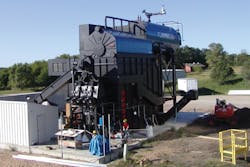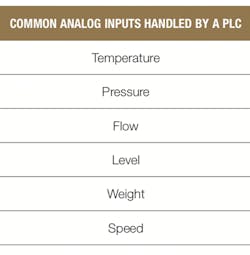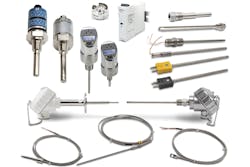All programmable logic controllers (PLCs) are connected to some field devices. Whether it is discrete input signals, analog signals or via a communications protocol, the PLC must have data from external devices to control and monitor a process.
Discrete signal inputs are relatively easy to select, connect and configure because the factors involved are limited to primarily the voltage (AC or DC), switching speed and wiring requirements.
Analog inputs, however, are more complex because analyzers, instruments and other devices produce a wide variety of signals. This article will discuss selection, connection and configuration of analog devices to interface to and integrate with a PLC.
DCS not required
Table 1.
Although a distributed control system (DCS) is the choice for many large, plant-wide process control applications, PLCs are also highly capable of process control. Part of this capability is related to the many different types of analog inputs a PLC can handle, as listed in Table 1.
Temperature signals are probably the most popular and include thermocouples, resistance thermal devices (RTDs) and thermistors (see Figure 1). Thermocouples offer fast measurement speed and are often the lowest-cost solution.
RTDs have a more limited temperature range, but are more accurate and repeatable. The construction of an RTD, often a length of wire wound around a glass or ceramic core, can lead to a slower response to temperature changes.
A thermistor, a thermally sensitive resistor, also has a smaller sensing range when compared to a thermocouple, making it more useful for commercial than industrial applications. These devices are more sensitive to temperature changes than RTDs, offering a fast response.
Pressure is another key process signal. Air pressure and compressed gas measurement are very common. Fluid pressure, such as hydraulic and water, are other popular measurements. While most pressure transducers come in voltage and current configurations, other use digital communications to send a scaled value (see Figure 2).
Flow measurement of liquid media offers reliable flow detection via a switched, pulsed output from an inline device, or via an analog output proportional to flow rate with a transmitter. Flow transmitters often use a sensing principle based on differential pressure, which can be fast and precise. Mag meters operate using current-carrying coils to generate a magnetic field to measure flow rate of conductive materials in a pipe.
Level transmitters are often installed on tanks and vessels, and many different types are available including radar, differential pressure and ultrasonic.
Weight is another process signal monitored by a PLC. The signals originate from load cells or strain gauges. Speed process signals are available using tachometers and encoders.
Signal methods
The process signals discussed are transmitted to a PLC in a variety of ways including discrete, analog, specialty modules and communications. Discrete signal inputs such as over temperature, pressure okay, level high and flow okay are common and have a home in many process applications.
Analog signals are also very common. Most flow, level, pressure and load cell devices are analog, typically current or voltage such as 4–20 mA, 0–10 VDC or +/-10 VDC.
Specialty PLC input modules are available for thermocouple, RTD and thermistor signals. Other specialty modules include high-speed input modules with timer, counter, pulse/direction and quadrature signal functions.
Digital communication options are also available such as serial, EtherNet/IP, IO-Link, EtherCat and others. For example, a load cell connected to a panel meter can display the calibrated weight and transmit it via RS232 to the PLC for process control. The main advantage of digital data links is the ability to send data in addition to the process variable including secondary variables, diagnostics and calibration information.
Figure 1. This assortment of ProSense industrial temperature sensors from AutomationDirect includes thermocouple probes, RTD sensors, analog temperature transmitters and thermowells. Figures 1 and 2 courtesy of AutomationDirect
Specifications and signal processing
When connecting these process signals to a PLC, several important specifications should be considered including: resolution, signal error, stability and electrical isolation. The resolution of the signal must meet the needs of the process. For example, will 12-bit data work for the process, or is higher resolution, such as 16-bit, needed?
The amount of acceptable signal error must also be considered. This error may be in the form of a slowly changing process signal causing unwanted variations in a system that may require quick detection of process signal changes. An example of this may be temperature of an oven, with the result being process overshoots if the error is excessive.
Stability of the signal is another factor to consider. Changes in environmental conditions can affect the process signal. Temperature changes may offset the signal, and mechanical wear can cause signal drift as well.
Electrical isolation may be needed to eliminate signal issues. Electrical noise can cause many issues with process signals from field devices. Signal conditioners often play an integral part in eliminating noise and ground loop problems.
Once a process signal is properly received at the PLC, it often still needs processing and handling, including filtering and scaling. Raw signals can be scaled in the PLC, often using dedicated function blocks.
Some devices — typically those with digital communication — allow internal configuration or calibration. Some PLC modules provide calibration or other converting functions within hardware configuration parameters. A PLC program can also be written to calibrate a process signal device, and to prompt the operator to perform the needed steps to complete the calibration.
While some devices have built-in displays, many others do not. The numeric value of these scaled process signals is valuable to the operator, technician and supervisor of the process. PLCs can communicate with human machine interface (HMI) systems to display these signals in a usable format.
Figure 2. These AutomationDirect ProSense pressure sensors monitor pressure in many process applications, providing discrete and analog signals in wide measurement ranges for both pneumatic and hydraulic circuits.
A need for process signals
There is a long list of applications requiring process control. An application utilizing a wide variety of process signals is a wood-fired or biofueled boiler. Much of the boiler process must be monitored and controlled to ensure it meets its main purpose, safely providing steam in an energy-efficient manner (see Top Photo).
Pressure is an important process signal in boilers, with steam demand and header pressure directly related. A PLC monitoring boiler pressure will also likely monitor other variables such as temperature, level and flow.
The steam pressure is monitored for process control and safety purposes. The draft pressure is also monitored and controlled. Often a variable frequency drive (VFD) controls a fan to maintain the proper pressure in the combustion chamber. A low draft alarm — often due to motor, belt or damper failures — must shut down the combustion system. An oxygen sensor may also be used to drive a combustion air fan. As more fuel is added, the oxygen level decreases, but with the PLC monitoring oxygen levels, more combustion airflow can be provided by increasing fan speed.
The PLC monitors many temperature sensors for makeup water, water fed into coils, steam temperature and temperature drop at several locations throughout the boiler. Sensors also monitor for over-temperature in the burner. A high temperature may signal the PLC to remove heat from the system using a water spray to slow the combustion process. Additionally, a high temperature may trigger the PLC to flood the system to prevent a fire at the feed end that could burn back into the fuel storage area.
Level sensors are used to monitor chip and sawdust levels to ensure enough solid fuel is available. The PLC also monitors the level of a water tank used for makeup water and the level of condensate tanks.
Flow of water through several parts of the boiler is monitored as well. Air flow may also be monitored to detect issues such as blockages, and to help fine-tune the process.
Correct signal levels and PLC hardware must be used to make connections to analog devices. The specifications of all the devices involved must be carefully checked, and signal processing will often be needed to monitor and control the process.




